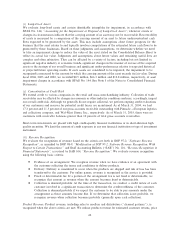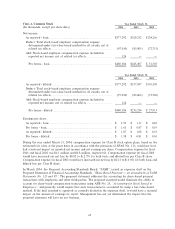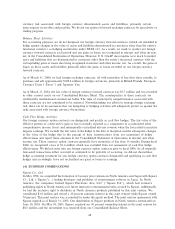Electronic Arts 2004 Annual Report Download - page 84
Download and view the complete annual report
Please find page 84 of the 2004 Electronic Arts annual report below. You can navigate through the pages in the report by either clicking on the pages listed below, or by using the keyword search tool below to find specific information within the annual report.In Japan, the companies established Electronic Arts Square K.K. (""EA Square KK'') in 1998, which
localized and published in Japan; a selection of EA's properties originally created in North America and
Europe, as well as developed and published original videogames in Japan. We contributed cash and had a
70 percent majority ownership interest, while Square contributed cash and owned 30 percent. Accordingly, the
assets, liabilities and results of operations for EA Square KK were included in our Consolidated Balance
Sheets and Consolidated Statements of Operations since June 1, 1998, the date of formation. Square's
30 percent interest in EA Square KK was reÖected as ""Minority interest in consolidated joint venture'' on our
Consolidated Balance Sheet as of March 31, 2003, and Consolidated Statements of Operations for the years
ended March 31, 2003 and March 31, 2002.
In May 2003, we acquired Square's 30 percent ownership interest in EA Square KK for approximately
$2.5 million in cash. As a result of the acquisition, EA Square KK has become our wholly owned subsidiary
and has been renamed Electronic Arts K.K. The acquisition was accounted for as a step acquisition purchase
and the excess purchase price over fair value of the net tangible assets acquired, $1.2 million, was allocated to
goodwill.
(5) GOODWILL AND OTHER INTANGIBLE ASSETS
EÅective April 1, 2002, we adopted the provisions of SFAS No. 141, ""Business Combinations'', which
requires business combinations initiated after June 30, 2001 to be accounted for using the purchase method of
accounting and acquired intangible assets meeting certain criteria to be recorded apart from goodwill. We
evaluated our goodwill and intangibles acquired prior to June 30, 2001 using the criteria of SFAS No. 141,
which resulted in $41.5 million of other intangibles being recorded separately from goodwill and $4.0 million
of acquired workforce intangibles being subsumed into goodwill at April 1, 2002. In addition, eÅective April 1,
2002, we adopted the provisions of SFAS No. 142, ""Goodwill and Other Intangible Assets''. SFAS No. 142
requires that purchased goodwill and certain indeÑnite-lived intangibles no longer be amortized; rather,
goodwill will be subject to at least an annual assessment for impairment by applying a fair-value-based test.
SFAS No. 142 also requires, among other things, reassessment of the useful lives of existing recognized
intangibles and the testing for impairment of existing goodwill and other indeÑnite-lived intangibles. Upon
adoption, we evaluated the estimated useful lives of existing recognized intangibles and determined that the
estimated useful lives of all such assets were appropriate.
Upon adoption of SFAS No. 142, we ceased amortizing goodwill (see goodwill information in table below). In
lieu of amortization, SFAS No. 142 requires a two-step approach to testing goodwill for impairment for each
reporting unit. The Ñrst step tests for impairment by applying fair value-based tests at the reporting unit level.
The second step (if necessary), measures the amount of impairment by applying fair value-based tests to
individual assets and liabilities within each reporting unit. We completed the Ñrst step of transitional goodwill
impairment testing during the quarter ended June 30, 2002 and found no indicators of impairment of our
recorded goodwill. As a result, we recognized no transitional impairment loss in Ñscal 2003 in connection with
the adoption of SFAS No. 142. We completed our annual impairment test in the fourth quarter of Ñscal 2004
and 2003 with a measurement date of January 1, 2004 and January 1, 2003, respectively, and found no
indicators of impairment of our recorded goodwill. There can be no assurance that future impairment tests will
not result in a charge to earnings and there is a potential for a write down of goodwill in connection with the
annual impairment test in future periods.
69
























